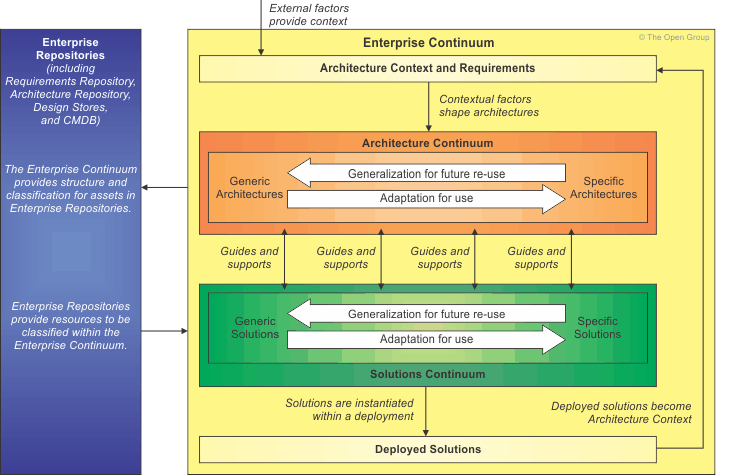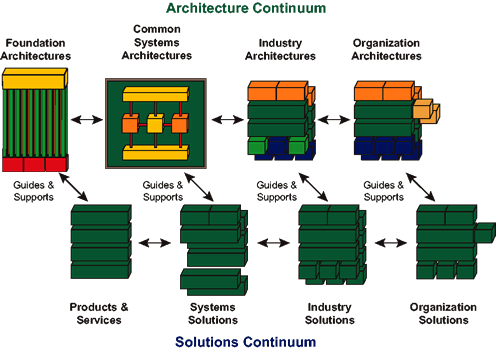The Enterprise Continuum is a fundamental concept in the TOGAF framework, providing a structured approach to classifying and managing architecture and solution artifacts. It helps organizations understand how generic solutions can be adapted to meet specific needs, promoting reuse, consistency, and efficiency. This guide explores the components of the Enterprise Continuum, focusing on the Architecture Continuum and Solutions Continuum, and provides practical examples to illustrate their application.

Understanding the Enterprise Continuum
The Enterprise Continuum is a view of the Architecture Repository that shows the evolution of architectures from generic to organization-specific within an enterprise. It comprises two main components: the Architecture Continuum and the Solutions Continuum.
Architecture Continuum
The Architecture Continuum is a repository of architectural elements, providing a structured classification of reusable architecture assets known as Architecture Building Blocks (ABBs). It helps organizations define, understand, and manage the rules, representations, and relationships within an architecture.
Key Aspects:
-
Repository of Architectural Elements:
- The Architecture Continuum serves as a library of architectural artifacts, including principles, models, patterns, and guidelines that can be reused across the enterprise.
Example:
- Scenario: A financial institution wants to standardize its data management practices.
- Implementation: The institution uses the Architecture Continuum to store and manage data architecture principles, data models, and integration patterns, promoting consistency and reuse across different departments.
-
Structuring of Architecture Building Blocks (ABBs):
- ABBs are reusable architecture assets that define specific functionalities and can be assembled to create more complex architectures.
Example:
- Scenario: A retail company is developing a new customer loyalty program.
- Implementation: The company identifies ABBs for customer data management, loyalty points calculation, and rewards redemption, which can be reused and adapted for the new program.
-
Classification Mechanism:
- The Architecture Continuum classifies assets at different levels of evolution, from generic to organization-specific, enabling traceability and derivation relationships.
Example:
- Scenario: A manufacturing company is implementing an Industry 4.0 initiative.
- Implementation: The company uses the Architecture Continuum to classify architectural assets from generic IoT frameworks to industry-specific manufacturing solutions, ensuring a structured evolution of the architecture.
-
Consistent Method for Architecture Definition:
- The Architecture Continuum provides a consistent method to define and understand the rules, representations, and relationships in an architecture.
Example:
- Scenario: A healthcare provider is developing a new electronic health record (EHR) system.
- Implementation: The provider uses the Architecture Continuum to define data governance rules, system integration representations, and relationships between different components of the EHR system.
-
Evolution from Foundation to Organization-Specific Architectures:
- The Architecture Continuum illustrates how architectures evolve from Foundation Architectures to Organization-Specific Architectures, promoting reuse and eliminating redundancy.
Example:
- Scenario: A global corporation is standardizing its IT infrastructure.
- Implementation: The corporation uses the Architecture Continuum to evolve its architecture from a generic IT service management framework to a tailored solution that meets the organization’s specific needs and regulatory requirements.
-
Discovering Commonality and Eliminating Redundancy:
- The Architecture Continuum helps identify common architectural elements and eliminate unnecessary redundancy, promoting efficiency and consistency.
Example:
- Scenario: A multinational company is consolidating its enterprise resource planning (ERP) systems.
- Implementation: The company uses the Architecture Continuum to identify common ERP components and eliminate duplicated functionalities, streamlining the architecture and reducing costs.
-
Reference Library Classification Scheme:
- The Architecture Continuum can be viewed as a reference library classification scheme, organizing architectural assets in a structured and accessible manner.
Example:
- Scenario: An educational institution is developing a new learning management system (LMS).
- Implementation: The institution uses the Architecture Continuum as a reference library to classify and manage architectural assets related to the LMS, ensuring easy access and reuse of components.
The Solutions Continuum
The Solutions Continuum is a repository of solution building blocks (SBBs), which are implementations of architecture building blocks (ABBs). It provides a structured approach to managing reusable solutions that can be adapted to meet specific organizational needs.
Key Aspects:
-
Repository of Solution Building Blocks (SBBs):
- The Solutions Continuum serves as a library of reusable solution components, including software applications, services, and infrastructure elements.
Example:
- Scenario: A software development company is creating a suite of enterprise applications.
- Implementation: The company uses the Solutions Continuum to store and manage reusable software components, such as authentication services, data integration tools, and user interface elements.
-
Implementations of Architecture Building Blocks (ABBs):
- SBBs are specific implementations of ABBs, providing concrete solutions that can be reused and adapted across the enterprise.
Example:
- Scenario: A financial services company is implementing a new customer relationship management (CRM) system.
- Implementation: The company identifies SBBs for customer data management, sales automation, and marketing campaigns, which are implementations of the corresponding ABBs.
-
Evolution from Generic to Organization-Specific Solutions:
- The Solutions Continuum illustrates how solutions evolve from generic components to organization-specific implementations, promoting reuse and eliminating redundancy.
Example:
- Scenario: A manufacturing company is implementing a new supply chain management system.
- Implementation: The company uses the Solutions Continuum to evolve its solution from a generic supply chain framework to a tailored system that meets the organization’s specific needs and operational requirements.
The TOGAF Architecture Development Method (ADM) and the Enterprise Continuum
The TOGAF ADM uses the Enterprise Continuum to transition from the TOGAF Foundation Architecture to an enterprise-specific architecture. The Enterprise Continuum helps determine existing assets to ease this transition, promoting reuse and efficiency.
Key Activities:
-
Leveraging Existing Assets:
- Architects use the Enterprise Continuum to identify and leverage existing architectural and solution assets, promoting reuse and reducing development time and costs.
Example:
- Scenario: A retail company is developing a new e-commerce platform.
- Implementation: The company uses the Enterprise Continuum to identify existing architectural patterns and solution components that can be reused for the new platform, accelerating development and ensuring consistency.
-
Continuous Change and Improvement:
- The architecture development activity exists within a wider enterprise lifecycle of continuous change. The Enterprise Continuum supports this lifecycle by providing a structured approach to managing architectural and solution assets.
Example:
- Scenario: A healthcare provider is continuously improving its electronic health record (EHR) system.
- Implementation: The provider uses the Enterprise Continuum to manage architectural and solution assets, ensuring that improvements are consistent, reusable, and aligned with organizational goals.
TOGAF Reference Models
TOGAF provides two reference models that can be included in an organization’s Enterprise Continuum:
-
TOGAF Foundation Architecture:
- A set of generic services and functions that provide a foundation for more specific architectures to be developed.
Example:
- Scenario: A global corporation is standardizing its IT service management practices.
- Implementation: The corporation uses the TOGAF Foundation Architecture as a starting point, adapting the generic services and functions to meet the organization’s specific needs and regulatory requirements.
-
Integrated Information Infrastructure Reference Model (III-RM):
- Based on the TOGAF Foundation Architecture, the III-RM enables and supports a Boundaryless Information Flow vision, promoting seamless information exchange across the enterprise.
Example:
- Scenario: A multinational company is implementing a new data governance framework.
- Implementation: The company uses the III-RM to guide the integration of data management components, ensuring seamless information flow and compliance with regulatory requirements.
Classifications of Potential Architectures
The Enterprise Continuum includes four main classifications of potential architectures, illustrating the evolution from generic to organization-specific solutions:

-
Foundation Architecture:
- Consists of generic components, inter-relationships, principles, and guidelines to build more specific architectures.
Example:
- Scenario: A software development company is creating a new enterprise application.
- Implementation: The company uses a Foundation Architecture to define the basic components and principles, which are then adapted to meet the specific needs of the application.
-
Common Systems Architectures:
- Provide a common set of components and services that can be reused across different systems and solutions.
Example:
- Scenario: A retail company is implementing a new point-of-sale (POS) system.
- Implementation: The company uses Common Systems Architectures to define reusable components, such as payment processing and inventory management, which are then adapted for the new POS system.
-
Industry Architectures:
- Guide the integration of common systems components with industry-specific components, creating industry solutions for targeted customer problems.
Example:
- Scenario: A healthcare provider is implementing a new patient management system.
- Implementation: The provider uses Industry Architectures to define the integration of common systems components, such as data management and security, with industry-specific components, such as clinical workflows and regulatory compliance.
-
Organization-Specific Architectures:
- Tailored to meet the specific needs and goals of an organization, ensuring alignment with strategic objectives and operational requirements.
Example:
- Scenario: A manufacturing company is implementing a new supply chain management system.
- Implementation: The company uses Organization-Specific Architectures to define a tailored solution that meets the organization’s specific needs, such as custom workflows, integration with existing systems, and compliance with industry standards.
Conclusion
The Enterprise Continuum is a powerful concept in the TOGAF framework, providing a structured approach to classifying and managing architecture and solution artifacts. By leveraging the Architecture Continuum and Solutions Continuum, organizations can promote reuse, eliminate redundancy, and ensure consistency and efficiency in their architecture development activities. This comprehensive guide, along with practical examples, illustrates how the Enterprise Continuum can be applied to real-world scenarios, driving successful architecture projects and achieving strategic goals.